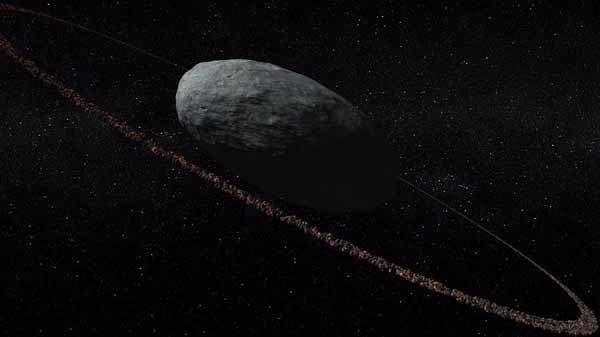

An illustration of the dwarf planet Haumea and its ring system. It was seen through telescopes in Europe on Jan. 21, 2017. (IAA-CSIC/UHU)
New York, US (BBN) - There may be more ringed objects in the outer solar system than anyone knew.
This week, researchers revealed that the egg-shaped dwarf planet Haumea — one of four known diminutive planets that circle the sun from beyond the orbit of Neptune — is surrounded by a ring of material roughly 43 miles in width, reports the Los Angeles Times.
Although rings are well known around Saturn (obviously) as well as Jupiter, Neptune and Uranus — the new discovery represents the third time in just the last few years that scientists have found a ring around a solar system object that is not a planet.
The new work, published Wednesday in the journal Nature, suggests that ring systems in the outer solar system are not uncommon, said Amanda Sickafoose, an astronomer at MIT and the South African Astronomical Observatory in Cape Town who was not involved in the research. She said we can anticipate additional ring-related discoveries in the future.
DISCOVERY
Haumea’s ring was found by an international team of astronomers working on an ongoing program to characterize Trans-Neptunian Objects, or objects that are farther from the sun than Neptune.
Because these relatively small bodies are so far away, they are difficult to see even with the most sophisticated telescopes.
“Unfortunately, even with the largest telescopes on Earth, and even with the Hubble Space Telescope, we cannot see anything more of Haumea than a dot of light,” said Jose Ortiz of the Institute of Astrophysics of Andalusia in Spain, who led the research.
But there are other ways to glean information about distant objects.
To better understand Trans-Neptunian Objects, Ortiz and his colleagues often use a technique known as stellar occultation. By measuring minute changes in the amount of light a star gives off as an object passes in front of it, they can determine the body’s size, shape, the amount of light it reflects, whether it has an atmosphere and whether or not it has rings.
In this study, the authors relied on data collected by 12 telescopes located in Italy, Germany, Hungary, Slovakia, Slovenia and the Czech Republic.
Small dips in starlight recorded at all these locations just before and just after Haumea briefly blocked a star provided the clues that the dwarf planet is surrounded by a ring of material approximately 600 miles from its surface.
The authors were also able to determine that Haumea’s rings are considerably darker than its surface — perhaps by as much as a factor of five.
A PATTERN EMERGES
Ortiz and his colleagues were the first to discover rings around a nonplanetary object back in 2013. At that time, they detected a pair of rings around a 155-mile-wide comet-asteroid hybrid known as Chariklo.
“We had puzzling data that we did not know how to reconcile," Ortiz said in 2014, when the discovery was published. "But when I realized that an elliptical ring could explain all the secondary occultation events, I almost jumped out of my seat!"
In 2015, the same team found evidence of possible ring material around a similar object called Chiron, although that discovery is not universally accepted by the scientific community.
Ortiz said the discovery of a ring around Haumea still came as a shock, because, with a length of 1,218 miles, Haumea is significantly larger than either Chiron and Chariklo.
But the era of ring surprise might be over.
“Now, after finding a ring around Haumea, rings should not come as a surprise anymore,” he said.
AN OUTER SOLAR SYSTEM PHENOMENON
Scientists are not entirely sure what causes rings to occur, and it may be different for different bodies.
In the case of Haumea, it’s possible that the dwarf planet suffered a high-speed impact that released enough material that some of it remained in orbit around it — unable to accrete again and form a satellite.
Also, Haumea has a very fast spin rate — it makes a complete rotation once every four hours. Because of this, Ortiz said, it is also possible that the dwarf planet’s rings could have been caused by what is known as rotational fission or mass sheddings.
“In this case the centrifugal force is so high that material might be able to escape, and even a small collision can trigger a large mass shedding,” he said.
It also turns out that there are a few reasons why ring systems would be more common in the outer solar system than the inner solar system.
For example, collision speeds in the outer solar system are considerably slower than in the inner solar system. If rings are formed when two objects collide, they are more likely to do so in the inner solar system, where the ejected material might not be moving fast enough to escape the gravity of a central body, Ortiz explained.
Rings in the outer solar system are also likely to be more stable than in the inner solar system because the sun is so much farther away, and therefore the perturbing forces of solar radiation are much weaker.
It’s also possible that there are more rings in the outer solar system because there are simply more satellites there than in the inner solar system. That means there are more objects that could create rings in the first place.
WHAT’S NEXT
Ortiz and his collaborators are continuing to use occultation to study bodies in the outer solar system and see whether any of them have rings.
It’s still unclear how many objects out there are big enough and have the right properties to sustain rings, but he said there are some indirect clues that suggest that as much as 30% of objects larger than 124 miles across could have rings.
“This would mean that thousands of bodies could have rings,” he said. “But currently this is just speculation.”
BBN/MMI/ANS